
Romantic and fast on the hunt, the double rifle nonetheless has its drawbacks well worth considering before staring down dangerous game.
What You Need To Consider In A Double Rifle:
- It is, primarily, a close-quarter rifle, though there are means and methods that can be employed to stretch things out a bit further.
- Figure out what species you plan to hunt, this will give you a handle on what caliber you'll require.
- Given some of the rare chamberings, you need to take ammunition availability into account or pay through the nose to shoot it.
- These are generally large caliber rifles, therefore you must realistically appraise your personal recoil tolerance or suffer accuracy issues.
- Many feature two triggers, in turn, require practice to master.
- A proper stock fit is a must to manage recoil, milk the most speed out of the rifle and improve accuracy shot to shot.
More likely than not, you’ve seen the images or read the stories: a broad-shouldered African professional hunter standing on the grassy plain, with a large-caliber double rifle over his shoulder, held just shy of the muzzle. It’s most definitely an iconic image, evoking a link to the Golden Era of Safari, and it’s an image that inspired me as a young hunter.
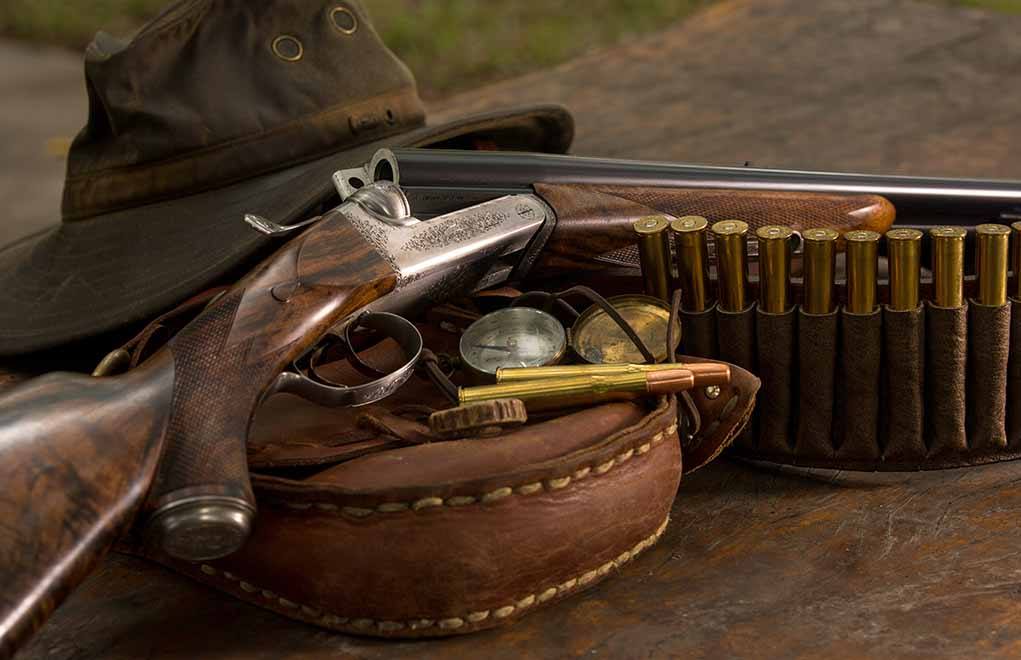
Double rifles certainly have a romantic appeal; they’re usually chambered for the larger Nitro Express calibers, they have clean lines and they offer a fast second shot for stopping dangerous game. While all of this may be true, there are some caveats that need to be addressed for those who may own or plan to own a double rifle. There are also many pleasures associated with owning a double, and I feel the two sides of the equation should be explained.
The Cartridges
While there are quite a few double rifles in smaller calibers — the various 7mms, some .30s and certainly the 8mms — it’s the double rifles in the dangerous-game calibers that garner the most attention. I consider the bare minimum bore diameter for dangerous game work to be the 9.3mm; while it’s not legal for dangerous game in all countries, it really is a capable diameter, offering 286- and sometimes 300-grain bullets at respectable velocities.

The dangerous-game calibers run up though the .577 and .600 Nitro Express, and for the truly brave, the .700 Nitro, though the latter two are certainly rarities. The most popular choices for the double rifles, which predominately house rimmed cartridges, are the .450/400 3-inch NE, the .450 NE, the .470 3¼-inch NE and the .500 3-inch NE, with the .375 Flanged and 9.3x74R pulling up the rear. There are many choices among used double rifles, including the .450 No. 2, .475 No. 2 Jeffery, .500/465 NE, as well as the .375 H&H Belted, .458 Winchester Magnum and other non-rimmed cartridges.
It’s these cartridges on the larger side of the spectrum that are relied upon to successfully hunt, and often stop, a dangerous animal. The majority have a rather sedate muzzle velocity, ranging from 2,050 fps (in the case of the .450/400 3-inch NE) up to 2,400 fps, with most aiming for the 2,150 fps mark. These mild velocities result in a rifle/cartridge combination that isn’t exactly stellar for long-range work, but that’s also not the role that the double rifle is trying to fill. The double rifle is, primarily, a close-quarter rifle, though there are means and methods that can be employed to stretch things out a bit further, but more about that in a moment.
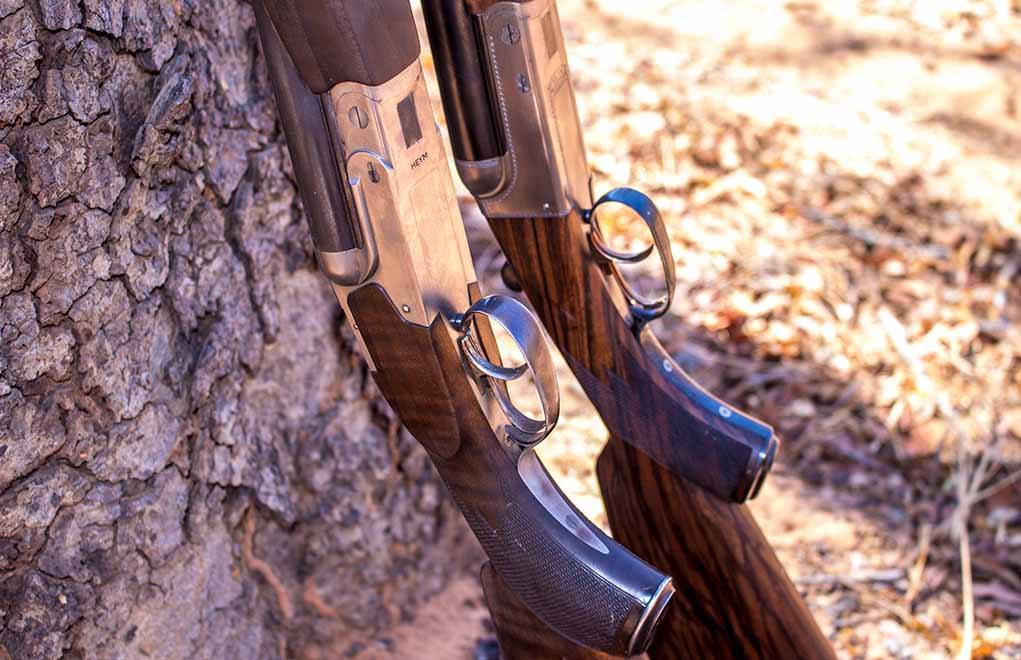
Were I to offer advice on choosing a cartridge for your double rifle, I would have you look at the following points: potential species to be hunted, availability of good ammunition and your personal recoil limit. There’s no point in carrying a .500 NE if you can’t shoot it accurately; a .450/400 3-inch in the right place is worth ten .500s in the wrong place. Finding a great bargain on a .475 No. 2 Jefferys won’t do you much good if you can’t obtain reliable, quality ammunition for it. It’s also unwise to purchase a double rifle in a caliber which won’t effectively handle all of your hunting needs; if you’re serious about hunting elephant, choose a cartridge that will cleanly take the big pachyderms under any circumstance.
Hunt Out More Dangerous Game Rifles And Ammo Info:
- 9 Best Dangerous Game Guns Ever Made
- 11 Serious Dangerous Game Optics
- The 10 Best Dangerous Game Cartridges
- 5 Dangerous Game Bullets To Bet Your Life On
- Can You Trust Dangerous Game Handloads?
Understanding Regulation
The double rifle is a unique situation, when it comes to the performance of the ammunition. Unlike a single-barreled rifle — which will have a selection of varying bullet weights and velocities for which the sights or scope may be easily adjusted — the double rifle will be regulated for a particular bullet weight, at a specific velocity.

For example, if your .470 NE was regulated with Hornady ammunition — as my Heym Model 89B was — it will give its best performance with that ammo, or other ammo that replicates the bullet weight/velocity formula. During the regulation process, the manufacturer will wire the two barrels together and carefully place small wedges between the barrels until they obtain the accuracy they desire; only then will the ribs be permanently attached.
Some of the inexpensive rifle manufacturers have been known to adjust the crown of the muzzle to regulate the rifle; while some of them have shot well after that treatment, it’s not an ideal technique. Most double rifles are set to have the bullets cross paths at about 75 yards, giving acceptable accuracy out to 150 yards or so, in a perfect world.
When you receive your rifle, my advice is to shoot it with the regulation ammo — you may need to contact the manufacturer to find out what your rifle was regulated with — in order to establish a benchmark of your abilities with the rifle. At that point you’ll have a feel for what the rifle can do, and then start to experiment with other ammunition.

Please just keep in mind that if you have a .470 for example, it will almost always be regulated with 500-grain bullets, and you’re married to that bullet weight. My own .470 was regulated with Hornady ammo, and if I deviate from that velocity too much, the bullets start to strike a different place, and possibly show degradation in group spread.
Using my own rifle as an example, I shot the excellent Federal Premium load, featuring the 500-grain Trophy Bonded Bear Claw bullet. While the ammunition is wonderfully precise – I get 1-inch pairs from a right/left barrel combo — the velocities are a bit hotter, and the bullets print about 3 inches high and 3 inches left. This could be adjusted with a higher front sight and a drift of the rear sight, but I opted to use their component bullets to handload my ammunition at the velocity the rifle was regulated for. If you were ordering a new rifle, I think it wouldn’t be too difficult to specify which ammunition you’d like to use, and have the company regulate the rifle for that ammunition.

As a point of interest, the Hornady ammunition my rifle was regulated with clocks in a 2,095 fps instead of the target 2,150 fps, and that’s no issue at all. Subtle variations in barrel construction can have that same effect in any single-barreled rifle, and the double rifle is equally prone to that phenomenon.
Sighting Systems For Double Rifles
The classic double rifle is set up with iron sights in the safari express pattern, that is a 140-degree wide “V” rear sight, and a rather bold brass bead front sight; sometimes multiple rear leaves for extended distances will be provided. The timeless irons are still very effective, though they certainly have their limitations, especially as the shooter ages.
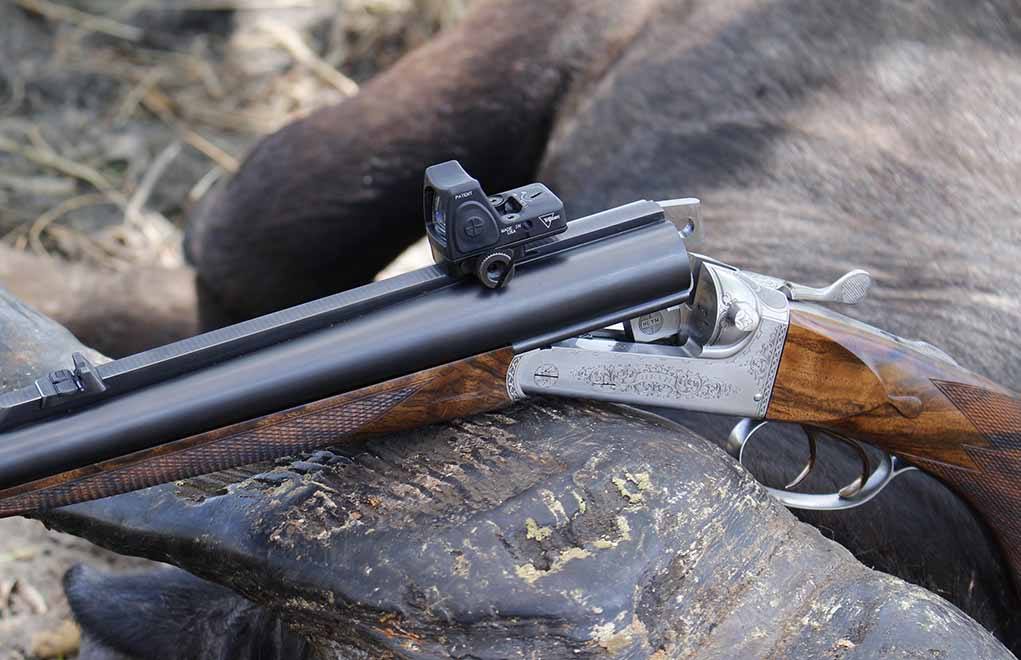
Simply put, as we age, our ability to focus three objects simultaneously declines. In addition, the front bead covers nearly 10 inches at 100 yards. While I’ve used iron sights to take many dangerous game animals, the use of iron sights does come with a price: You will want to get closer, though that’s not always a terrible thing. Elephant hunting is a game played inside of 40 yards, but buffalo can offer shots a bit further.
Scoping a double rifle is not an impossibility, though I can attest to the fact that it does affect the balance of the rifle. One of the best benefits of the double rifle is the quick pointing nature, and scoping your double definitely gives it a different feel. At the very least, you’ll need a set of detachable mounts so you can access your iron sights. However, I feel that all the benefits of a scope on a double rifle can be achieved with the use of a red-dot, without any of the balance issues.
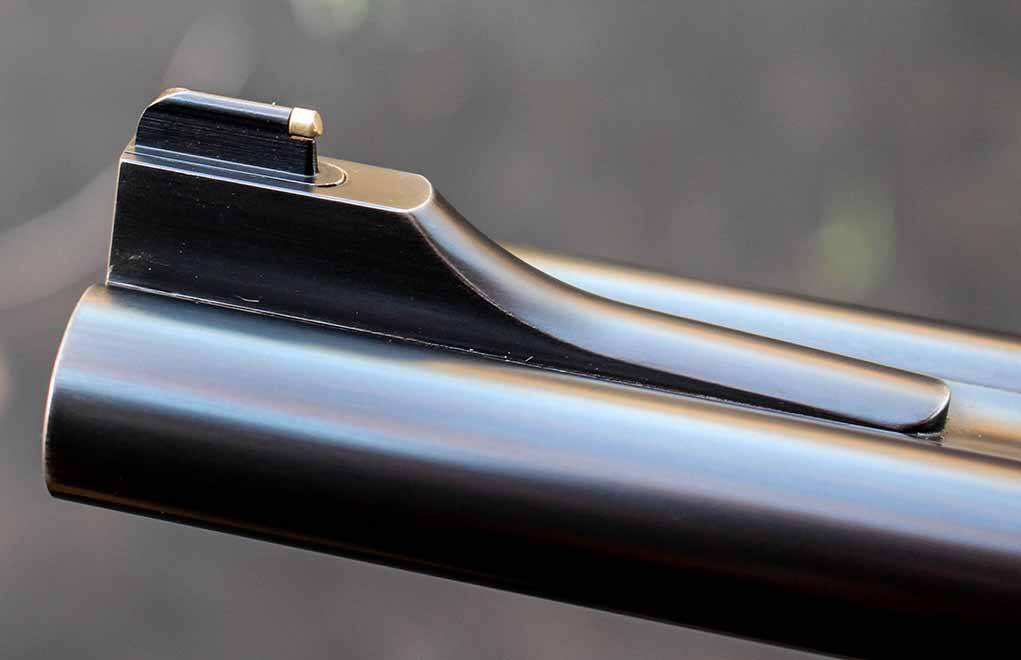
The red-dot sighting systems alleviate a couple of issues with a double rifle. One, it relives the user of the need for multiple focal planes, as you simply superimpose the red-dot into the aiming point. Two, the dot is available is varying diameters — my personal favorite is the Trijicon RMR RM09, which has a 1-MOA dot — so the issue of a big, brass bead covering much of the target is gone. That RM09 weighs a mere 1.2 ounces, and balance is not affected in the least.
I’ve used this sight on a Heym .470 for a huge-bodied water buffalo in Arnhemland, Australia, at just 17 paces, and it was wonderful. My buddy Chris Sells used the same rifle later that week to take another good bull at 125 yards. The Trijicon is not the only one on the market; I like the Docter sight as well. If you have issues with iron sights, I’d highly recommend either of those to solve the issue, while maintaining the clean lines and balance of your rifle.
Two Triggers, Different Mindset
A double rifle, according to some, was designed to be two rifles in one package; should something happen to one barrel/trigger, a hunter in the wilds of the world would still have the other to get him through. Most doubles will come equipped with two triggers, and a hunter who is unfamiliar with that setup — shotgunners are likely to be familiar with a two trigger setup — will have to do some practicing.
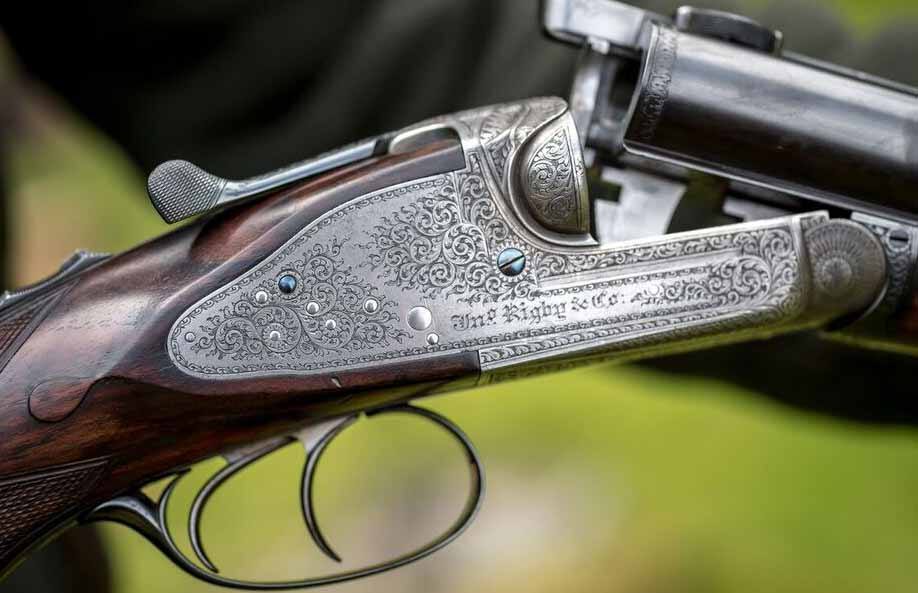
Many shooters, the author included, will find themselves reaching for the front trigger again after firing that barrel. It will take practice — and I recommend a good set of snap caps for inexpensive practice — to develop the mechanics to reach for the second trigger each and every time. Some folks swear that using the back trigger (left barrel) first will prevent an accidental double discharge; however, that feels completely unnatural to me. Instead, I do a ton of snap cap drills, repetitively firing the combination of right barrel, then left barrel.
Rifle Fit
As with any hard-kicking dangerous game rifle, stock fit is paramount, but with a double rifle — designed for quick pointing, close-quarter work — you want that gun to come to shoulder like a fine shotgun. Almost all doubles are stocked for use with iron sights, and a proper double rifle will be stocked to fit your frame; I was measured for the stock of my Heym 89B, and it has quickly become an old friend.
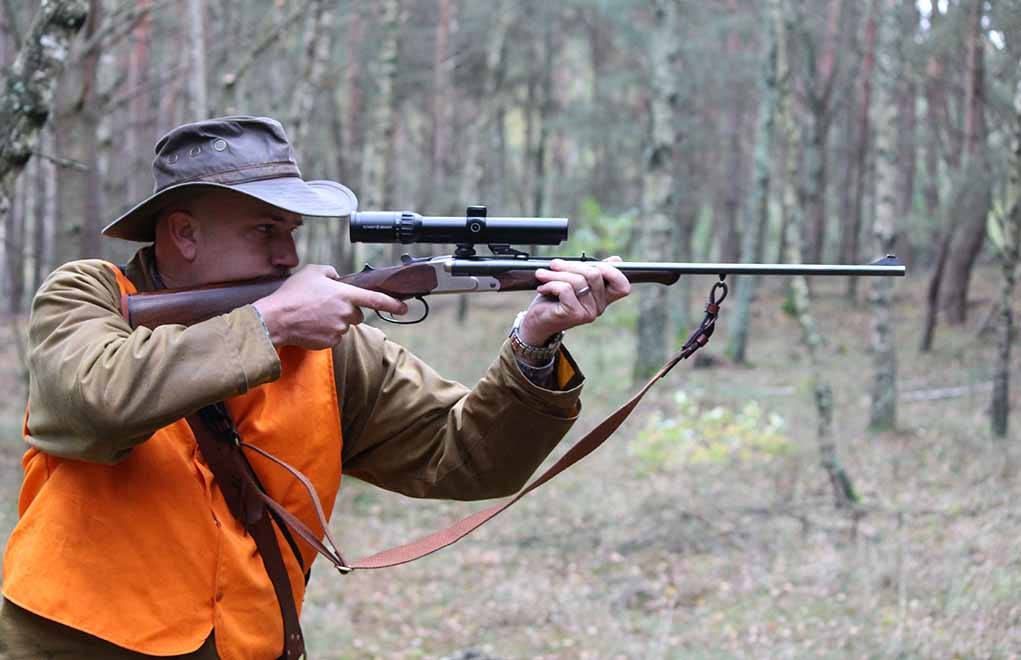
Proper stock fit invariably results in better shooting, and that counts when it comes to dangerous game in thick bush. A poor-fitting stock will ramp up felt recoil, and no matter how attractive the price, it can make an otherwise manageable cartridge rather uncomfortable. I personally feel that stock fit is one of the most important characteristics of a proper double rifle; if you have an opportunity, get measured by a knowledgeable salesman, and then handle a rifle that fits you well. I’d bet you’ll be shocked by the length of pull that fits you properly, and how natural the rifle feels.
The Brand Name Game
I’m not going to make any bones about it; I’m a Heym guy for a number of reasons: Their product is very well-designed — the German engineering is outstanding, and the modern revisions give the rifles a British feel — as well as affordable, as far as doubles go. If you are well-heeled enough, there are many British brand names that have an impeccable reputation.
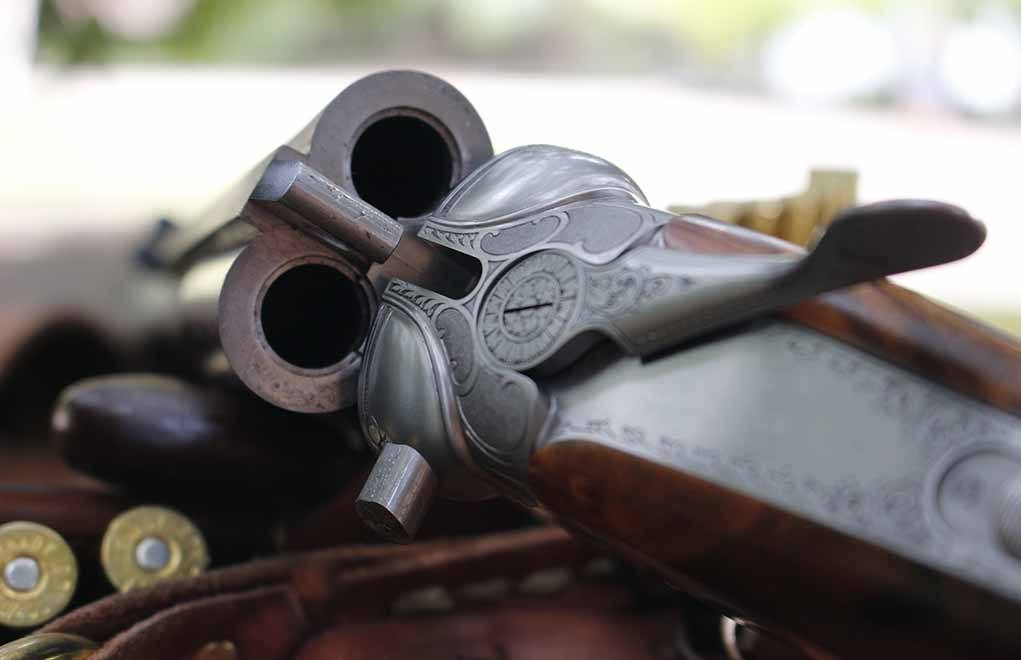
Holland & Holland, Westley Richards, John Rigby & Co., Purdey — all are excellent rifles. I’ve had the pleasure of shooting some of these, and they’re wonderful, even if some models come with six-figure price tags. There are more affordable choices, like Krieghoff, Merkel, Verney-Carron, Chapuis and others; if they fit you well and you’re comfortable with the appointments, they can give excellent service. All double rifles are expensive, and you usually get what you pay for, cosmetics aside.
Side Lock Vs. Box Lock
This argument has raged on among double rifle owners for decades, with no end in sight. Side locks are classy and strong, and box locks are simple and strong enough. Personally, I feel that the side lock rifles are wonderful to look at, but the additional cost puts them out of my price range.
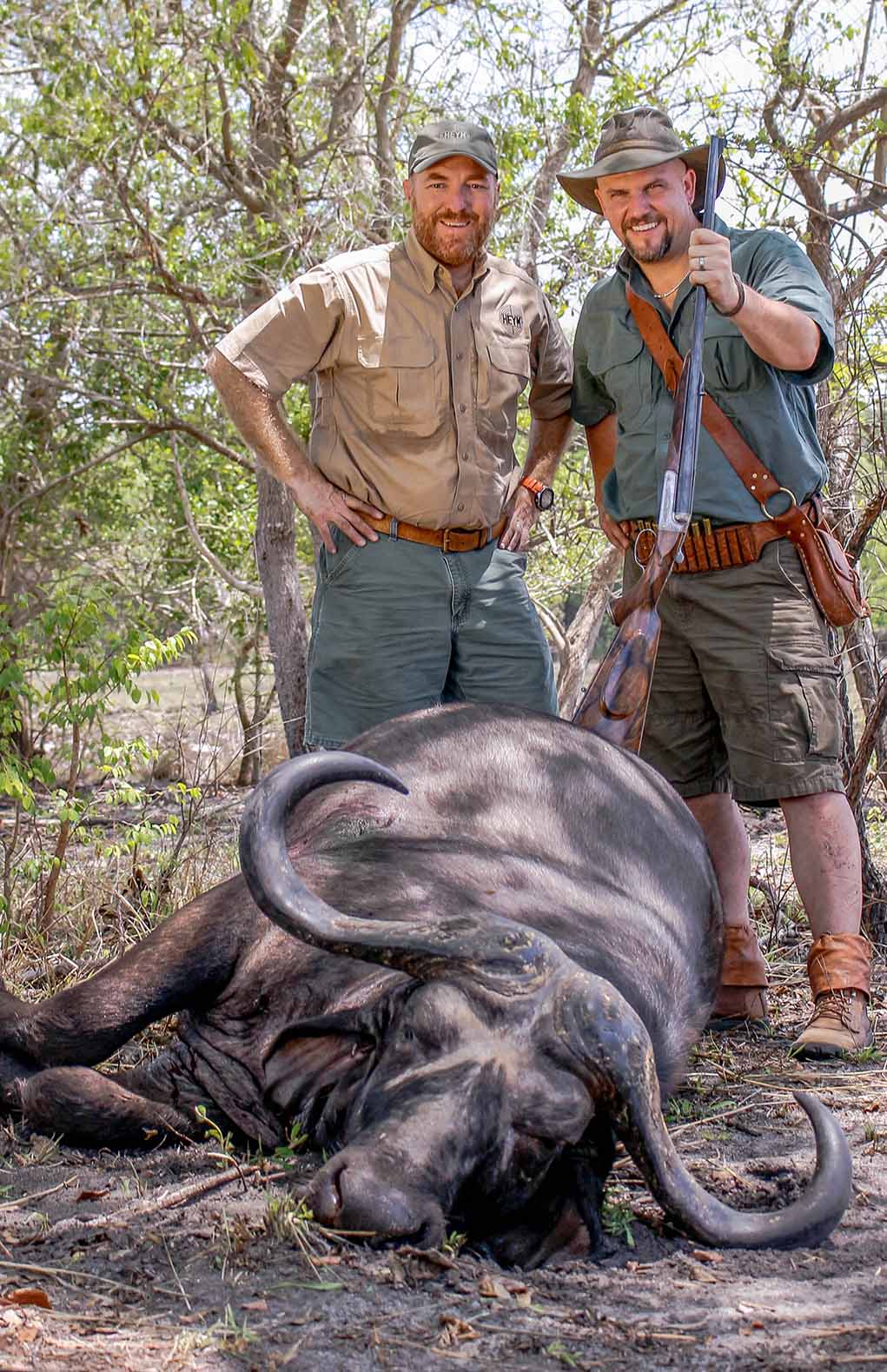
The various box locks have more than proven themselves over the years, and when given extra reinforcement — like the Greener crossbolt added to the already strong Anson & Deeley box lock on the Heym 89B — can be stronger than needed.
Reloading For Double Rifles
Reloading for the doubles requires a different mindset. The consistency in technique is still important, but what you’re trying to do is take two barrels that are welded together and get them to strike the same point of impact. The mission is to obtain the velocity that the rifle was regulated for, and in my own case that was right around 2,000 fps. The chronograph will certainly be one of the most useful tools for this particular project, as the target will show you how the accuracy will come together as the target velocity is approached.
Generally speaking, you should make up several pairs of cartridges, from the lowest charge weight to the listed maximum, in 1-grain increments. As the velocity starts out low, with the lowest charge weight, the pair of bullets will print low on the target, with considerable separation. As the regulation velocity is approached, the pairs will print closer together and closer to the point of aim. The hotter loads will rise in comparison to point of aim, and then widen in the opposite direction.
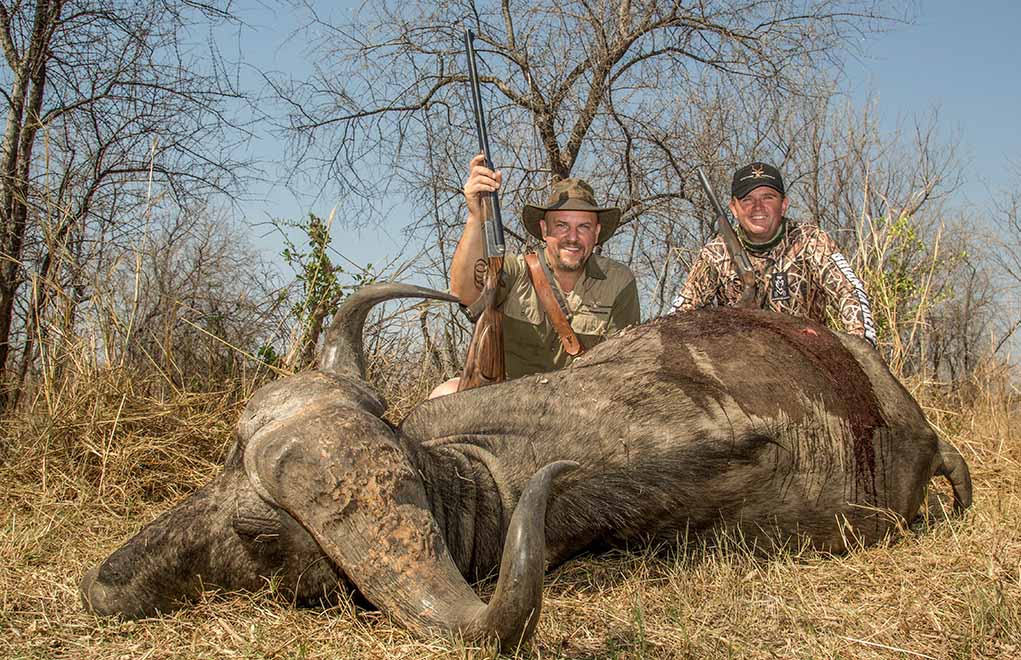
Keeping an eye on the velocities and the consistency between the barrels, you will have to find the sweet spot for your chosen bullet/powder combination. It’s the synchronicity between the barrels that will matter more than the last few fps, as most of the cartridges offer enough energy to get the job done, even if velocities drop off 50 fps or so.
Powder choice can and will make a huge difference in certain cartridges as well, as I found in my .470 NE. Using the standard H4831SC for my safari handloads with Peregrine softpoints, I did achieve acceptable accuracy and velocities, driving the 500-grain slugs at 2,140 fps. However, after discussing the matter with Chris Sells of Heym, he steered me to Alliant’s Reloder 15. It uses much less powder — 87 to 90 grains of RL-15 compared to 110 to 112 grains of H4831SC — but the ultimate benefit was a considerable and much-appreciated reduction in recoil. The lighter charge weight in that big 3¼-inch case requires a filler to keep the powder evenly pressed against the primer; I used the Kynoch No. 2 wads.
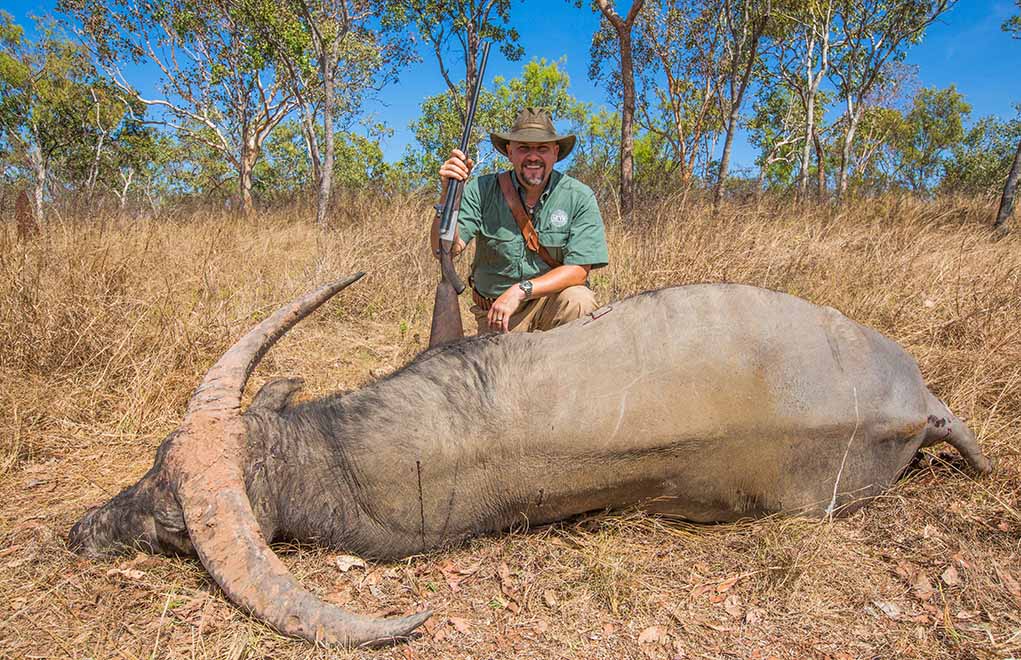
Sparked by a Federal Gold Medal Match GM215M primer, I got two Peregrine softpoints to print about an inch apart at 100 yards, at 2,160 fps. Two Cape buffalo bulls in Zimbabwe’s Chirisa Safari Area did not approve of the effectiveness of this load. Backed up by Federal’s Trophy Bonded Sledgehammer solids, these soft-points provided all the accuracy I could ask for from an iron-sighted double and my 47-year old eyes.
Handloading your safari ammunition gives you both the ability to customize your ammunition, as well as reducing the financial burden. Factory ammunition for the Nitro Express cartridges isn’t cheap — sometimes in excess of ten dollars per round — and handloading cuts that in half, if not more.
In Conclusion
Is a double rifle a necessity for hunting dangerous game? No, even the largest game animals can be taken cleanly with a bolt action rifle, which is considerably more affordable. However, the history and panache of the double rifle is undeniable. There is no faster second shot on dangerous game than a double rifle; however, the bolt rifle offers a faster third shot. I love them both, but carrying my .470 into the jesse bush of Zimbabwe, or in the thick forests of Mozambique where elephant and buffalo are encountered at less than ten paces at times engenders all sorts of confidence.
Is the double rifle for everyone? Probably not, but new rifles are in high demand, and in my opinion the double rifle has survived the turmoil of the 1970s and early 80s, when Nitro Express ammunition was virtually unavailable and safari at its darkest hour. I know that I cherish every moment with my own double rifle, and every scratch on the stock and worn patch of bluing has become a fond memory to me.
Editor's Note: This article originally appeared in the December 2018 issue of Gun Digest the Magazine.

Next Step: Get your FREE Printable Target Pack
Enhance your shooting precision with our 62 MOA Targets, perfect for rifles and handguns. Crafted in collaboration with Storm Tactical for accuracy and versatility.
Subscribe to the Gun Digest email newsletter and get your downloadable target pack sent straight to your inbox. Stay updated with the latest firearms info in the industry.

![Best Concealed Carry Guns In 2025 [Field Tested] Wilson Combat EDC X9S 1](https://gundigest.com/wp-content/uploads/Wilson-Combat-EDC-X9S-1-324x160.jpg)


![Best 9mm Carbine: Affordable PCCs [Tested] Ruger Carbine Shooting](https://gundigest.com/wp-content/uploads/Ruger-Carbine-Shooting-100x70.jpg)
![Best AR-15: Top Options Available Today [Field Tested] Harrington and Richardson PSA XM177E2 feature](https://gundigest.com/wp-content/uploads/Harrington-and-Richardson-PSA-XM177E2-feature-100x70.jpg)

I see the advantage in the 89 .. however, the 88 is magnificent.
Wow this article is no doubt a eye opener, thank you ! I’ve spent years and more thinking about how great to be able to go on safari , but many article’s later and now yours has greatly opened my perspective on just how much one needs to learn about the double rifel.
Having reloading experience in my life I’ve not taken any thought to the amount of precision one must have to keep a great set of doubles hitting the mark time and again , you have opened my eyes, thank you.
Well there is a whole bunch of extra addadditions to my bucket list , but because of all who have gone before me I will such as yourself I won’t be overspending or underprepaired but the bucket list is still alive.
Thanks so very much for the article, and time taken to read this sincerely